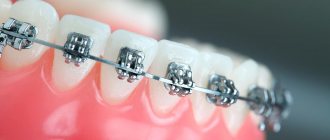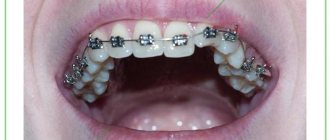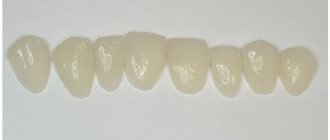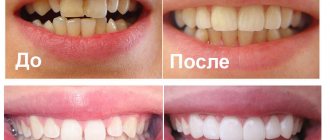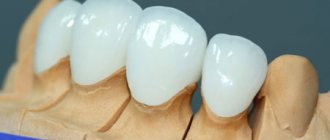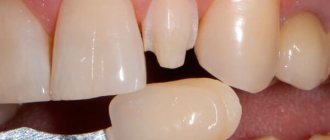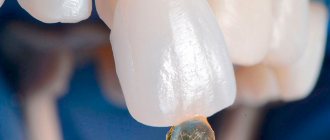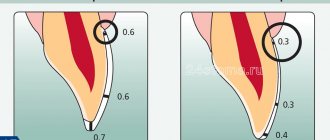Dentists admit: there are very few people satisfied with their smile. But the vast majority of patients, as a rule, sooner or later come to terms with both the imperfect shape of their teeth and their yellowish tint, convincing themselves that the main thing is health. And only a few continue to look for more and more new ways to correct the imperfections given by nature.
Fortunately, modern aesthetic dentistry has something to offer. Correct minor malocclusions, change the color and shape of teeth using veneers, thin plates that are firmly glued to the front surface of the tooth. All that remains is to understand how composite veneers differ from ceramic ones, and which one should be preferred.
Complete prosthetics with veneers is impossible. Overlays are intended only for correcting enamel defects, masking chips and diastemas. In case of extensive carious lesions, dentists still use crowns.
10% discount on veneers and crowns
Moscow
Differences between composite and ceramic veneers
Veneers made of composite material are otherwise called direct - due to the method of creation. The doctor plays the record in 1.5 - 2 hours while the patient is in the dental chair. In some cases, an impression is taken of the teeth and the veneers are cast from the impression in the laboratory.
Direct veneers are extremely firmly connected to the tooth tissue, this is facilitated by the layer-by-layer technology of applying a composite to damaged enamel. It is impossible to tear the created plate from the foundation. The tightness of the composite veneer is extremely high - there is not the slightest gap between the base and the coating that could provoke the growth of pathogenic flora. At the same time, the composite veneer retains its plasticity and does not cause discomfort. Preserving color and transparency for many years, the prosthesis maintains the impression of the naturalness of the restored tooth.
Ceramic veneers or zirconium veneers are made exclusively in a dental laboratory using high-precision impressions. They are attached to the patient's teeth using a specially developed adhesive. There are several known methods for making ceramic veneers: pressing under pressure, casting on a refractor, cutting from a molded blank. These thin plates in finished form also very reliably imitate the appearance of human enamel, so correcting the aesthetics of a smile with such overlays is always successful.
What's more expensive?
On average, the price of a ceramic veneer in dental clinics in the capital is almost 2 times higher than the cost of installing a composite onlay. This is understandable, because at least 2 specialists work on creating the plate: a dentist and a dental technician. And in addition to paying for their services, the cost of ceramic veneers also includes depreciation of expensive laboratory equipment and the cost of purchasing the consumables themselves.
It’s easier with composite veneers, since they are made directly in the patient’s mouth by the dentist himself. And since the final result largely depends on the skill of the doctor, the price varies greatly from clinic to clinic. You can get a composite veneer installed by a novice doctor much cheaper than by a professional with a capital “P.” But will the result justify itself?
Features of direct veneers
People choose this restoration method for a number of reasons:
- It's inexpensive and fast. Composite veneers are installed in one clinic visit; there is no need to plan long-term treatment or schedule trips to the dentist. The cost of the composite is much lower than the production of ceramics.
- The removal of enamel from the surface of the teeth is extremely minimal, sometimes only required in places.
- There is a clear similarity between composite veneers and the enamel of natural teeth.
- It is attracted by the high adhesion of the artificial material to living tissues.
The technique has some disadvantages:
- The quality of the final composition greatly depends on the experience and qualifications of the doctor. This drawback, however, is inherent in any result of a dentist’s work.
- Tarnishing of a record over the years. It can be eliminated by polishing the veneer once every six months.
- Changes in the color of the veneer due to frequent consumption of coloring foods and drinks. Cannot be corrected.
- Corrosion of a composite veneer under the influence of ethanol occurs with regular drinking of alcohol and when rinsing the mouth with alcohol-containing rinses.
Indications for installation of overlays
Composite onlays will help correct any minor enamel defects and aesthetic imperfections of the smile:
- chips;
- enamel irregularities;
- microcracks;
- large gap between the front teeth;
- old darkened fillings;
- stains on teeth that cannot be whitened.
If the patient is categorically not satisfied with his smile, ceramic veneers will be a more effective solution. With their help, you can radically change the situation: create a Hollywood smile, correct wedge-shaped teeth, crowded incisors, and correct your bite. The installation of ceramic veneers is also recommended for worn-out tooth enamel, as well as for too small teeth.
Pros and cons of ceramic veneers
The advantages of silicon oxide overlays are obvious:
- Lack of ability to oxidize, change color, or degrade. Ceramic veneers do not absorb pigments from food and do not disintegrate under the influence of acids and alcohols. They will not show any stains or discoloration throughout their entire service life.
- Ceramic veneers will last for more than a decade if initially installed correctly and handled with care.
- The plate is very durable, despite its microscopic thickness, not reaching even a millimeter.
- Imitation of enamel is the best among other veneering techniques.
Flaws:
- The cost of ceramic veneers is not affordable for every patient.
- The impossibility of quick prosthetics sometimes becomes extremely difficult. A person will have to visit the clinic at least twice: to take impressions and for final installation. In addition, you will have to spend money on making a temporary structure, which will need to be worn until the permanent veneers are glued.
- When preparing teeth for veneers, the doctor may overheat the tooth pulp, which can lead to inflammation and acute toothache.
Porcelain veneers require grinding down of the teeth. Composite veneers do not have high strength and durability. There is a better alternative to all options: install veneers without grinding your teeth Luxneers
Life time
Veneers, like no other element of prosthetics, have often become the subject of scientific research and experimentation. It seemed too implausible even to dentists that the thinnest plates could someday seriously compete with crowns. But time after time, researchers got the same result:
- the average service life of a composite plate is 5 years, subject to regular grinding and polishing;
- porcelain veneers will almost certainly last 10-15 years.
Patients often request replacement of composite veneers after 2-3 years. The most common reason is darkening of the material. But if you treat ceramic plates with care, they may not need to be replaced and will last much longer than their average service life. Since the main reasons for their failure are chips, cracks, fractures resulting from injury or personal negligence.
In 2007, scientists began a large-scale study. It involved 300 patients with ceramic veneers. After 10 years, in 91% of patients the plates retained their original appearance. According to the plan, the next examination is scheduled for 2022, and scientists predict that ceramic veneers will remain intact in 73% of patients.
Reasons for installing veneers
If one or two teeth require restoration, it is more profitable to install composite veneers, but ceramics are not at all prohibited. If there are many cosmetic defects and you need to cover three or more teeth, it is advisable to use porcelain veneers.
General indications for veneering:
- Masking darkening of enamel, the presence of erosive areas, small chips and cracks, stains.
- Correction of hypersensitivity of teeth.
- Improving the appearance of the tooth after treatment of pulpitis or caries. Behind the veneer, like behind a shield, it is possible to hide fillings and tooth darkening as a result of nerve removal.
- Changing the shape of the tooth, giving the effect of uniformity in the row.
- Covering interdental spaces and wide crevices.
When choosing to improve the aesthetics of your smile with veneers, you will have to follow the instructions of your dentist. The doctor has the right to refuse to place veneers on the patient if the following diseases are traced in the anamnesis:
- Bruxism (uncontrollable night grinding of teeth);
- Deformation of gum tissue, periodontal disease, gingivitis, poor sanitary condition of the oral cavity;
- Too massive fillings on the teeth, exceeding the volume of remaining living tissue;
- Malocclusion;
- Allergy to components of the composite mass.
Do you still think that veneers without grinding of teeth Luxneers or composite are better?
Make an appointment
Or call +7(985)532-21-01
Rules of care
Modern dental ceramics are as durable as natural tooth enamel. Therefore, you shouldn’t be afraid to treat yourself to nuts or grilled sweets once again, just don’t open bottles with your teeth, and use mouthguards when doing active sports.
Another thing is composite linings. To extend their service life you will have to:
- stop smoking, otherwise your teeth will quickly turn yellow-brown;
- give up coloring foods: beets, wine, strong tea, fresh berries, coffee;
- Use cavity rinses that do not contain ethanol.
Abrasive toothpastes are contraindicated for both ceramic and composite veneers. To restore the smoothness of composite onlays, it is enough to visit the dentist once every 6-12 months for grinding.
Despite the fact that plaque does not form on ceramic linings, regular professional cleaning, at least once every six months, is also necessary in this case. But you need to trust your smile only to professionals!
Remember! Ultrasonic and popular abrasive methods of cleaning teeth Air Flow are strictly prohibited for patients with ceramic veneers. Both procedures violate the integrity of the plates.
Any problems with both composite and ceramic veneers require increased attention. Roughness and steps at the point of contact between the prosthetic material and tooth enamel cannot be ignored. If the veneer is not installed tightly, it may fall off at the most inopportune moment. And any, even the smallest, gap is a gateway to infection and a serious risk of developing caries.
Gums require no less attention. In areas of contact with veneers, they may bleed, swell, and hurt. It is dangerous to ignore such symptoms: in the case of a chronic inflammatory process, the doctor will be forced to remove the linings and start the entire restoration process all over again. To prevent this from happening, at the slightest irritation, make an appointment with a dentist you trust.
Main indications for use
Composite veneers are placed for different purposes. There are many indications for their use. Here are the most common reasons for installing veneers:
- incorrect position of teeth;
- stains on enamel that cannot be removed by bleaching or professional cleaning;
- cracks and chips;
- enamel erosion;
- diastema;
- unsightly fillings on the cervical area of the crown;
- certain malocclusions;
- minor irregularities;
- loss of a large part of the tooth.
In some situations, the doctor may refuse the patient or delay the procedure. The following contraindications for the installation of composite veneers are identified:
- malocclusions that can be corrected with braces;
- bruxism;
- damaged or naturally too thin enamel;
- bad habits (smoking, opening bottles with teeth, biting nails);
- employment in heavy production or passion for extreme sports;
- small crown, too crooked surface, too short teeth;
- poor dental hygiene, failure to take proper care of the oral cavity;
- diseases in the acute stage, inflammatory processes, carious cavities, viruses, infections and other problems that need to be eliminated;
- absence of nerve;
- mobile teeth.
Differences
Composite and porcelain veneers differ in many ways.
- Material. Componers are made from a special filling material, and their creation does not require the participation of outside specialists or a dental impression. Ceramic plates are formed from ceramics (porcelain) and production is carried out under special conditions.
- Production time. Componers have a ready-made base. They can be “tailored” to an individual patient during one visit to the dentist. Porcelain onlays require first making an impression of the teeth, from which they are subsequently made. This process may take several weeks.
- Installation method. The composite material is applied to the surface of the tooth, after which it is treated with a certain light (polymerized). Conventional onlays are glued to the enamel using a cement base.
- Lifetime. Componers have appeared in dentistry relatively recently; their service life is about 3 years. If you follow the wearing rules, it may be larger. Porcelain microprostheses last 10 years or more.
- Price. Prices for installing corrective onlays vary and depend on the clinic, the professionalism of the dentist, the region and the material used. There is a big price difference between componeers and porcelain onlays. The cost of composite material for one tooth is about 10 thousand rubles. Ceramics for one incisor costs almost 3 times more.
- Properties. The filling material is of lower quality. This is explained by the fact that componeers wear out faster, and darkening occurs on them over time. Ceramics last longer. With proper care, it does not darken for a long time, and damage does not appear on it.
- Feel. Consumer reviews say that componeers are less comfortable than veneers. The first coating option is rougher.
Installation (before and after)
After making the onlays, the doctor places them on the teeth. To do this, treat the surface of the teeth with an antiseptic solution and special glue. Composite veneers are fixed to the teeth one by one and illuminated with a light lamp. The remaining adhesive is removed using a dental instrument. After installation, the dentist talks about caring for the structure and gives recommendations.
Important points
Another positive effect of veneering is the improvement of gum health. This happens thanks to the perfectly adjusted contours of the veneer.
But there may be cases when the gums begin to become inflamed, ache or bleed. If you notice such manifestations, then something is wrong. Maybe there were some errors during installation, and you will need to return to your doctor for correction.
The main factors in which you should immediately consult a dentist:
- sore gums, swelling, bleeding, discomfort;
- the veneer does not fit perfectly to the tooth, mobility is felt;
- the appearance of gaps or roughness at the attachment point;
- in case of a chip of a part of the prosthesis;
- at the first manifestations of caries in the exposed part of the tooth.
After assessing the situation, the dentist can replace or correct the veneer. For example, in cases where a small part of it has broken off, you can polish the desired area without replacing it.
Can I use dental floss?
There are no clear prohibitions on the use of dental floss and interdental brushes, but you need to be extremely careful when using them. After prosthetics, microgaps between teeth are naturally preserved. But here it is very important not to move the thread from the gums to the edges (i.e., not to make vertical movements) - of course, not immediately, but gradually due to such actions the lining can be damaged. If you want to use floss, insert the tip not from below (from the cutting surface), but directly into the area between the teeth in the gum area - into the largest gap. After cleaning, remove it in the same way.
The same with brushes - when you remove them from the interdental space, be extremely careful. Choose the thinnest brushes. And best of all, buy an irrigator. This is an excellent replacement for both dental floss and brushes.
“Pay special attention to the condition of the gums, especially where the mucous membrane comes into contact with the edge of the veneer or lumineer. Due to tissue injury, inflammation may occur, which will lead to the fact that the pads will have to be removed for treatment, or due to a violation of aesthetics. For example, if gum recession begins and the roots of the teeth become exposed.”
Dzhutova Aida Vladimirovna Implant surgeon, periodontist Work experience more than 9 years make an appointment
Do you dream of a beautiful smile? We have developed COMPLEXES of veneers for the smile area - place 4, 6 or 12 onlays at once! Save up to 30 thousand rubles and get a Hollywood smile!
sign up now
Is it possible to smoke if you have veneers?
Of course, you need to give up smoking. Firstly, for the general health of the body. Secondly, in order to preserve the color of the veneers. Of course, they will darken along with the enamel of living teeth, so there will be no obvious contrast. But unlike natural teeth, they cannot be whitened – the process is irreversible. Thirdly, when smoking, the gums suffer greatly - with veneers, the risk of mucosal recession increases, and when smoking it is even higher. Therefore, if possible, it is still better to give up this bad habit. Or at least strengthen hygiene and visit a doctor for comprehensive cleaning 2-3 times more often.
What hygiene products should you have in your arsenal?
Hygiene products after installation of veneers and lumineers
| Name | Description |
| Toothbrush | Only with soft bristles - use it to clean the very surface of veneers and lumineers. Too hard hairs can lead to cracks. The teeth themselves can be brushed with a regular, medium-hard brush. Do not use electric brushes specifically for teeth with veneers - vibration can lead to the veneers coming off. Again, such brushes use quite aggressive bristles and even plastic elements that can damage the material and make it rougher - you should definitely avoid such attachments. |
| Toothpaste | Without the addition of abrasive particles (not bleaching!), such a paste can also lead to the formation of microcracks on the surface of the dentures. |
| Irrigator | Allows you to clean both the interdental spaces and the surface of the veneers from plaque. An additional bonus is a massage of the gums - the mucous membranes are saturated with oxygen, metabolic processes in them are restored. |
| Mouthwash | Choose the product that you need, taking into account your existing problems: to combat gum inflammation, to reduce tooth sensitivity, to strengthen enamel (with fluoride). |
What to choose: veneer, crown or braces
If there are no contraindications to installing veneers, it is better to give them preference. The main difference between the devices is that the use of a crown requires grinding of the tooth, which after such processing becomes like a “stump”. Sometimes it is necessary to remove the nerve. Installing a veneer involves removing the top layer of enamel on the front wall near the cutting edge.
Patients often choose between veneers and braces, not knowing which to choose. In fact, it all depends on how crooked the teeth are. Veneers only mask the defect and do not correct it. This method justifies itself only when the result is needed urgently or it is simply necessary to hide a defect.
Veneers can correct the bite only in cases of minor pathology. Doctors usually advise correcting the bite without grinding the enamel using braces.
Material
Ceramics is used for aesthetic restoration because it is as close as possible in optical properties and appearance to tooth enamel. The surface texture, light reflection, and the degree of transparency of the material are such that the restored crowns look natural.
Dental composite is more often used for filling and functional restoration of crowns. It is used less often in aesthetic restoration: it is not so transparent, the surface texture can change over time (become porous, less smooth). Composite reflects light differently than enamel. Because of all this, it does not look as natural, especially on the upper incisors, for which veneering is most often used. They can stand out and attract attention.
Ceramics and composite differ in strength and durability:
- ceramic plates do not wear off and are resistant to chips, microcracks, and other mechanical defects;
- the composite is not so durable: even with careful handling, it gradually deteriorates and requires regular polishing and periodic re-restoration.
Another selection criterion is color. The color of the installed veneers must exactly match the patient’s own enamel. When using ceramics, the shade is selected with maximum accuracy using a special color scale. For composite compositions there are fewer color gradations, which makes it more difficult to accurately select a shade.
After installation, the plates should not be stained by drinks, foods or darken over time. Ceramics are resistant to color changes: the structure of the material is dense, without pores on the surface, it does not absorb pigments or dyes. The density of the composite is lower. Gradually its color may change; it will stain faster than enamel. Because of this, the restored crowns will differ in appearance from the rest of the teeth.
